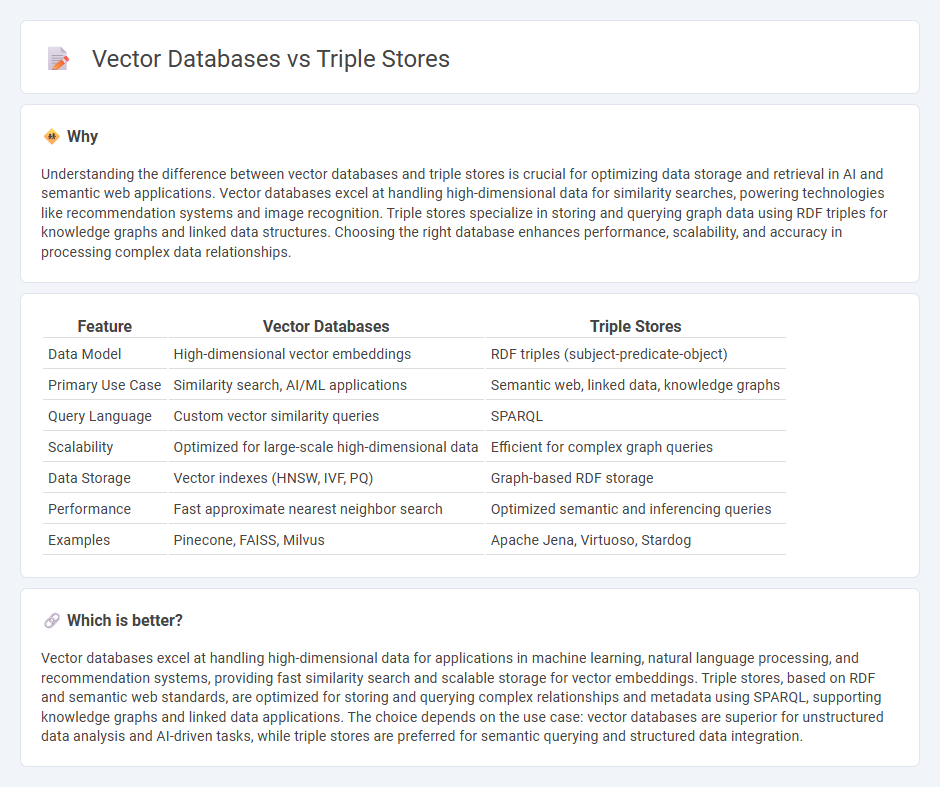
Vector databases excel in handling high-dimensional data for machine learning, enabling efficient similarity searches and rapid retrieval of unstructured information. Triple stores, rooted in semantic web technologies, manage structured data as subject-predicate-object triples, facilitating complex queries and reasoning over linked data. Explore the nuances and applications of vector databases and triple stores to understand their impact on modern data management.
Why it is important
Understanding the difference between vector databases and triple stores is crucial for optimizing data storage and retrieval in AI and semantic web applications. Vector databases excel at handling high-dimensional data for similarity searches, powering technologies like recommendation systems and image recognition. Triple stores specialize in storing and querying graph data using RDF triples for knowledge graphs and linked data structures. Choosing the right database enhances performance, scalability, and accuracy in processing complex data relationships.
Comparison Table
| Feature | Vector Databases | Triple Stores |
|---|---|---|
| Data Model | High-dimensional vector embeddings | RDF triples (subject-predicate-object) |
| Primary Use Case | Similarity search, AI/ML applications | Semantic web, linked data, knowledge graphs |
| Query Language | Custom vector similarity queries | SPARQL |
| Scalability | Optimized for large-scale high-dimensional data | Efficient for complex graph queries |
| Data Storage | Vector indexes (HNSW, IVF, PQ) | Graph-based RDF storage |
| Performance | Fast approximate nearest neighbor search | Optimized semantic and inferencing queries |
| Examples | Pinecone, FAISS, Milvus | Apache Jena, Virtuoso, Stardog |
Which is better?
Vector databases excel at handling high-dimensional data for applications in machine learning, natural language processing, and recommendation systems, providing fast similarity search and scalable storage for vector embeddings. Triple stores, based on RDF and semantic web standards, are optimized for storing and querying complex relationships and metadata using SPARQL, supporting knowledge graphs and linked data applications. The choice depends on the use case: vector databases are superior for unstructured data analysis and AI-driven tasks, while triple stores are preferred for semantic querying and structured data integration.
Connection
Vector databases and triple stores are connected through their shared capability to manage complex and large-scale data relationships, enhancing semantic search and knowledge graph applications. Vector databases optimize similarity search using high-dimensional embeddings, while triple stores structure data in subject-predicate-object format to encode semantic relationships. Integrating vector-based embeddings with triple store frameworks enables advanced reasoning and contextual search across interconnected datasets.
Key Terms
RDF (Resource Description Framework)
Triple stores specialize in storing and querying RDF data, enabling efficient handling of semantic relationships through subject-predicate-object triples. Vector databases excel in managing high-dimensional embeddings, which represent unstructured data like text or images for similarity searches but lack native support for RDF's semantic graph structure. Explore the differences to determine how each database type can optimize your semantic data processing needs.
Embeddings
Triple stores excel in storing and querying structured semantic data using RDF triples, enabling precise knowledge graph traversal and reasoning. Vector databases specialize in handling high-dimensional embeddings, optimizing similarity search and retrieval for unstructured data like images, text, and audio. Explore deeper to understand how embeddings integrate with both technologies for advanced AI and semantic applications.
SPARQL
Triple stores specialize in managing RDF data and are optimized for SPARQL queries, enabling efficient semantic data retrieval and reasoning across linked datasets. Vector databases store and query high-dimensional vector embeddings, focusing on similarity search rather than the structured querying capabilities provided by SPARQL. Explore the differences in query approaches and data models to understand which technology best fits your semantic data needs.
Source and External Links
What is a triple store in a knowledge graph? - Milvus - Triple stores are specialized databases for storing and managing data as triples (subject-predicate-object), forming the foundation of knowledge graphs and enabling flexible, scalable modeling of complex relationships.
Triplestore - Wikipedia - A triplestore, or RDF store, is a purpose-built database optimized for storing and retrieving semantic triples, typically queried using languages like SPARQL, and supports data interchange via RDF.
Triplestores 101: Storing Data for Efficient Inferencing - Dataversity - Triplestores are NoSQL databases that store data as subject-predicate-object statements (triples), support semantic web standards like URIs, and can handle large-scale data for analytics and inferencing.
 dowidth.com
dowidth.com